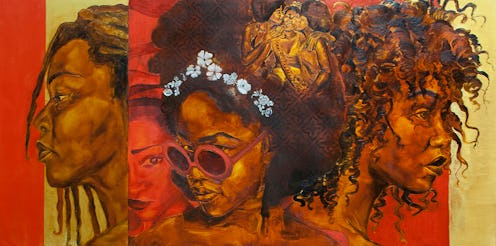News
This Art Show Aims To Help Women Run For Office

The Untitled Space, an art gallery in Lower Manhattan, recently unveiled its latest art exhibition: "She Inspires," a series of 60 works by various artists that aims to pay homage to inspirational women of the past and present. The show's emphasis on female empowerment is not limited to the art alone, however: 10 percent of its proceeds will go to She Should Run, a nonpartisan organization that helps women run for office.
"Right now more than ever, it is time for women to take a step forward and focus on leadership in their communities and beyond," exhibit curator Indira Cesarine said in a statement on the gallery's website. "The She Inspires exhibit aims to highlight, through the work of male and female contemporary artists, women throughout history who have made a positive impact."
The pieces within the exhibition vary significantly, a diversity that mirrors the identities and contributions of the women it features. The pieces at the exhibit range from video to sculpture to collage, some representational, others more abstract. All seek to celebrate the influence and contributions of an icon beloved by the artist.
Political activist Angela Davis, for example, appears in a textile portrait, created by artist Jess De Wahls, near the front of the gallery. De Wahls also contributed a textile portrait of artist Frida Kahlo.
Other pieces display their inspiration in a more abstract way: sculptor Cristin Millett's "Sever: Agatha's Offering" depicts a pair of hands holding a plate that appears to contain breast implants. St. Agatha was a Christian saint whose breasts were cut off as part of torture she endured for her religion; today, she is considered a patron saint for victims of breast cancer.
Other iconic women referenced in the exhibit's works ranged from political icons like Hillary Clinton, Linda Sarsour, and Michelle Obama, to pop culture legends like Marilyn Monroe and Barbra Streisand. Some pieces commemorate lesser-known women — Cesarine, for example, contributed an image of Victoria Woodhull, the first woman to run for president in the United States. The fact that no woman has become president, even 145 years after Woodhull's historic candidacy, demonstrates the importance of organizations like She Should Run.
At the exhibition's opening on May 2, the political purposes of the show were not far from many artists' minds.
"Representation matters," artist Anna Cone tells Bustle. She Inspires includes a print that Cone created, "Aphrodite," reminiscent of older Western depictions of goddesses, like the titular Greek goddess of love, but with a modern twist. "We're so used to seeing these goddess figures in our history, but through the male gaze," Cone says. Her work attempts to reclaim the depiction of women in art as something empowering.
Political involvement is a key part of that empowerment, Cone tells Bustle: "Especially in our current situation politically, I think women's representation is so important."
Other artists were inspired by the current political climate in different ways. Artist Linda Friedman Schmidt used discarded clothing to create her work, "A Corsage for Every Girl." This piece, Schmidt tells Bustle, was inspired by a maternal figure from her childhood. When Schmidt immigrated with her parents, who were Holocaust survivors, to the United States, a friend's mother, who made corsages for the girls in Schmidt's class, helped her feel welcome. "She was interested in lifting up young girls of all ethnicities," Schmidt explains. "She was a kind, empathetic, passionate person."
That small kindness when she was new to the United States made all the difference, Schmidt says, making her all the more aware of the concerns felt by those who come to America now. "The immigrant girls today feel the same way that I felt," she adds.
That simple gift from the mother of a friend also reminds Schmidt of the importance of empowering other women. When asked why organizations like She Should Run are significant, Schmidt replies, "Women understand. Women have empathy."
Schmidt's message about empathy for immigrants wasn't the only overtly political one on display. Video artist Sam Cannon displayed "The Glacier is the Center of the Universe," a black-and-white film inspired by visual artist Joan Jonas. "[Jonas's] work references climate change and issues with the environment," says Cannon, who tells Bustle she shot most of her footage on a glacier.
To Cannon, politics and art are natural companions. "I think that art always serves many functions," she says, "but for me, one of the most important things is that it helps you with your own struggles internally and then gives you a voice in the external world. You can reflect on and have catharsis with the issues you're dealing with, but also share that with the world."
The significant diversity of the works and artists represented in the exhibition illustrate the many ways one woman can have an impact on another. From Cone, who was inspired to reclaim images of goddesses, to Schmidt, whose life was so strongly impacted by another woman's act of kindness, to Cannon, whose work is inspired by a female leader in her field, the show underscores that empowerment can come from anywhere.
Since She Inspires aims to help raise money to enable women to run for office, its political purpose is clear. Yet in an age where women still struggle for political representation, basing an art show around the concept of inspirational women is, itself, a political act.